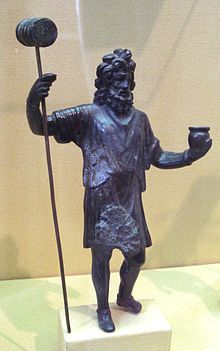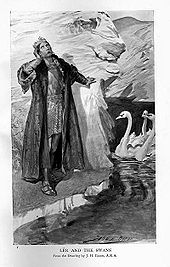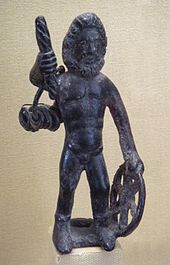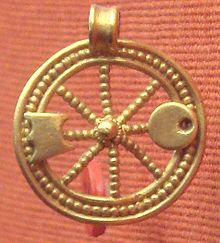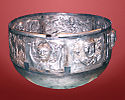- Celtic mythology
-
Series on
Celtic mythology

Celtic polytheism
Celtic deities (list)Gaelic mythology Irish mythology
Scottish mythology
Hebridean mythology
Tuatha Dé Danann
Mythological Cycle
Ulster Cycle
Fenian CycleBrythonic mythology British Iron Age religion
British mythology
Welsh mythology
Breton mythology
Mabinogion
Book of Taliesin
Trioedd Ynys PrydeinReligious vocations Festivals Samhain, Calan Gaeaf
Index of related articles
Imbolc, Gŵyl Fair
Beltane, Calan Mai
Lughnasadh, Calan AwstCeltic mythology is the mythology of Celtic polytheism, apparently the religion of the Iron Age Celts.[1] Like other Iron Age Europeans, the early Celts maintained a polytheistic mythology and religious structure. Among Celts in close contact with Ancient Rome, such as the Gauls and Celtiberians, their mythology did not survive the Roman empire, their subsequent conversion to Christianity, and the loss of their Celtic languages. It is mostly through contemporary Roman and Christian sources that their mythology has been preserved. The Celtic peoples who maintained either their political or linguistic identities (such as the Gaels, Picts, and Brythonic tribes of Great Britain and Ireland) left vestigial remnants of their ancestral mythologies, put into written form during the Middle Ages.
Contents
Overview
Though the Celtic world at its apex covered much of western and central Europe, it was not politically unified nor was there any substantial central source of cultural influence or homogeneity; as a result, there was a great deal of variation in local practices of Celtic religion (although certain motifs, for example the god Lugh, appear to have diffused throughout the Celtic world). Inscriptions to more than three hundred deities, often equated with their Roman counterparts, have survived, but of these most appear to have been genii locorum, local or tribal gods, and few were widely worshipped. However, from what has survived of Celtic mythology, it is possible to discern commonalities which hint at a more unified pantheon than is often given credit.
The nature and functions of these ancient gods can be deduced from their names, the location of their inscriptions, their iconography, the Roman gods they are equated with, and similar figures from later bodies of Celtic mythology.
Celtic mythology is found in a number of distinct, if related, subgroups, largely corresponding to the branches of the Celtic languages:
- Ancient Celtic religion (known primarily through archaeological sources rather than through written mythology; cf. Ancient Gaulish and British deities)
- mythology in Goidelic languages, represented chiefly by Irish mythology[2] and Scottish mythology:
- Mythological Cycle
- Ulster Cycle
- Fenian cycle
- Historical Cycle
- mythology in Brythonic languages, represented chiefly by Welsh mythology (cf. also Breton mythology and folklore)
Historical sources
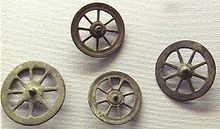 Votive Celtic wheels thought to correspond to the cult of Taranis. Thousands such wheels have been found in sanctuaries in Belgic Gaul, dating from 50 BCE to 50 CE. Musée d'Archéologie Nationale
Votive Celtic wheels thought to correspond to the cult of Taranis. Thousands such wheels have been found in sanctuaries in Belgic Gaul, dating from 50 BCE to 50 CE. Musée d'Archéologie Nationale
As a result of the scarcity of surviving materials bearing written Gaulish, it is surmised that the most of the Celtic writings were destroyed by the Romans, although a written form of Gaulish using the Greek, Latin and North Italic alphabets was used (as evidenced by votive items bearing inscriptions in Gaulish and the Coligny Calendar).[3] Julius Caesar attests to the literacy of the Gauls, but also wrote that their priests, the druids, were forbidden to use writing to record certain verses of religious significance[4] (Caesar, De Bello Gallico 6.14) while also noting that the Helvetii had a written census (Caesar, De Bello Gallico 1.29).
Rome introduced a more widespread habit of public inscriptions, and broke the power of the druids in the areas it conquered; in fact, most inscriptions to deities discovered in Gaul (modern France and Northern Italy), Britain and other formerly (or presently) Celtic-speaking areas post-date the Roman conquest.
Although early Gaels in Ireland and parts of modern Wales used the Ogham script to record short inscriptions (largely personal names), more sophisticated literacy was not introduced to Celtic areas that had not been conquered by Rome until the advent of Christianity. Indeed, many Gaelic myths were first recorded by Christian monks, albeit without most of their original religious meanings.[5]
Mythology of Ireland
The oldest body of myths stemming from the Heroic Age is found only from the early medieval period of Ireland.[6] As Christianity began to take over, the gods and goddeses were slowly eliminated as such from the culture. What has survived includes material dealing with the Tuatha Dé Danann and the Fomorians, which forms the basis for the text Cath Maige Tuireadh (the Battle of Mag Tuireadh), as well as portions of the history-focused Lebor Gabála Érenn (the Book of Invasions). The Tuatha Dé represent the functions of human society such as kingship, crafts and war, while the Fomorians represent chaos and wild nature.
The Dagda
The leader of the gods for the Irish pantheon appears to have been the Dagda.[7] The Dagda was the figure after which male humans and other gods were based due to his embodiment of the ideal Irish traits. Celtic gods were also considered to be a clan due to their lack of specialization and unknown origins. The particular character of the Dagda describes him as a figure of burlesque lampoonery in Irish mythology, and some authors even conclude that he was trusted to be benevolent enough to tolerate jokes at his own expense.
Irish tales depict the Dagda as a figure of power, armed with a spear. In Dorset there is a famous outline of an ithyphallic giant known as the Cerne Abbas Giant with a club cut into the chalky soil. While this was probably produced in relatively modern times (English Civil War era), it was long thought to be a representation of the Dagda. This has been called into question by recent studies which show that there may have been a representation of what looks like a large drapery hanging from the horizontal arm of the figure, leading to suspicion that this figure actually represents Hercules (Heracles), with the skin of the Nemean Lion over his arm and carrying the club he used to kill it. In Gaul, it is speculated that the Dagda is associated with Sucellos, the striker, equipped with a hammer and cup.
The Morrígan
The Morrígan was a tripartite battle goddess of the Celts of Ancient Ireland.[8] She was known as the Morrígan, but the different sections she was divided into were also referred to as Nemhain, Macha, and Badb (among other, less common names), with each representing different aspects of combat. She is most commonly known for her involvement in the Táin Bó Cúailnge.
Lugh/Lug
The god appearing most frequently in the tales is Lugh. He is evidently a residual of the earlier, more widespread god Lugus, whose diffusion in Celtic religion is apparent from the number of place names in which his name appears, occurring across the Celtic world. The most famous of these are the cities of Lugdunum (the modern French city of Lyon), Lugdunum Batavorum (the modern city of Katwijk, 10 kilometers to the west of Leiden) and Lucus Augusti or Λοuκος Λuγούστον (the modern Galician city of Lugo). Lug is described in the Celtic myths as the last to be added to the list of deities. In Ireland a festival called the Lughnasa (Modern Irish lúnasa) was held in his honour.
Others
Other important goddesses include Brigid (or Brigit), the Dagda's daughter; Aibell, Áine, Macha, and the sovereign goddess, Ériu. Notable is Epona, the horse goddess, celebrated with horse races at the summer festival. Significant Irish gods include Nuada Airgetlám, the first king of the Tuatha Dé Danann; Goibniu, the smith and brewer; Dian Cecht, the patron of healing; and the sea god Manannán mac Lir.
Mythology of Wales
Less is known about the pre-Christian mythologies of Britain than those of Ireland. Important reflexes of British mythology appear in the Four Branches of the Mabinogi, especially in the names of several characters, such as Rhiannon, Teyrnon, and Bendigeidfran (‘Bran [Crow] the Blessed’). Other characters, in all likelihood, derive from mythological sources, and various episodes, such as the appearance of Arawn, a king of the Otherworld seeking the aid of a mortal in his own feuds, and the tale of the hero who cannot be killed except under seemingly contradictory circumstances, can be traced throughout Indo-European myth and legend. The children of Llŷr (‘Sea’ = Irish Lir) in the Second and Third Branches, and the children of Dôn (Danu in Irish and earlier Indo-European tradition) in the Fourth Branch are major figures, but the tales themselves are not primary mythology.
While further mythological names and references appear elsewhere in Welsh narrative and tradition, especially in the tale of Culhwch and Olwen, where we find, for example, Mabon ap Modron (‘the Divine Son of the Divine Mother’), and in the collected Triads of the Island of Britain, not enough is known of the British mythological background to reconstruct either a narrative of creation or a coherent pantheon of British deities. Indeed, though there is much in common with Irish myth, there may have been no unified British mythological tradition per se. Whatever its ultimate origins, the surviving material has been put to good use in the service of literary masterpieces that address the cultural concerns of Wales in the early and later Middle Ages.
Remnants of Gaulish and other mythology
The Celts also worshipped a number of deities of which we know little more than their names. Classical writers preserve a few fragments of legends or myths that may possibly be Celtic.[9]
According to the Syrian rhetorician Lucian, Ogmios was supposed to lead a band of men chained by their ears to his tongue as a symbol of the strength of his eloquence.
The Roman poet Lucan (1st century AD) mentions the gods Taranis, Teutates and Esus, but there is little Celtic evidence that these were important deities.
A number of objets d'art, coins, and altars may depict scenes from lost myths, such as the representations of Tarvos Trigaranus or of an equestrian ‘Jupiter’ surmounting a snake-legged human-like figure. The Gundestrup cauldron has been also interpreted mythically.[10]
Along with dedications giving us god names, there are also deity representations to which no name has yet been attached. Among these are images of a three headed or three faced god, a squatting god, a god with a snake, a god with a wheel, and a horseman with a kneeling giant.[11] Some of these images can be found in Late Bronze Age peat bogs in Britain,[12] indicating the symbols were both pre-Roman and widely spread across Celtic culture. The distribution of some of the images has been mapped and shows a pattern of central concentration of an image along with a wide scatter indicating these images were most likely attached to specific tribes and were distributed from some central point of tribal concentration outward along lines of trade. The image of the three headed god has a central concentration among the Belgae, between the Oise, Marne and Moselle rivers. The horseman with kneeling giant is centered on either side of the Rhine. These examples seem to indicate regional preferences of a common image stock.[11]
Julius Caesar’s comments on Celtic religion and their significance
The classic entry about the Celtic gods of Gaul is the section in Julius Caesar's Commentarii de bello Gallico (52–51 BC; The Gallic War). In this he names the five principal gods worshipped in Gaul (according to the practice of his time, he gives the names of the closest equivalent Roman gods) and describes their roles. Mercury was the most venerated of all the deities and numerous representations of him were to be discovered. Mercury was seen as the originator of all the arts (and is often taken to refer to Lugus for this reason), the supporter of adventurers and of traders, and the mightiest power concerning trade and profit. Next the Gauls revered Apollo, Mars, Jupiter, and Minerva. Among these divinities the Celts are described as holding roughly equal views as did other populations: Apollo dispels sickness, Minerva encourages skills, Jupiter governs the skies, and Mars influences warfare. In addition to these five, he mentions that the Gauls traced their ancestry to Dis Pater.[13] MacBain argues that Apollo corresponds to Irish Lugh, Mercury to Manannan mac Lir, Jupiter to Dagda, Mars to Net, and Minerva to Brigit. [14]
See also
- Cornish folklore
- Fisher King
- Hag of the mist
- Táin Bó Flidhais
- Triskele
References
- ^ Cunliffe, Barry, (1997) The Ancient Celts. Oxford, Oxford University Press ISBN 0-19-815010-5, pp. 183 (religion), 202, 204-8.
- ^ O'Rahilly, T. F. (1946. (reprinted 1964, 1971, 1984)). Early Irish History and Mythology. Dublin: Dublin Institute for Advanced Studies. ISBN 0-901282-29-4.
- ^ Ross, Anne (1972). Everyday Life of the Pagan Celts. Carousel Books. pp. 166–167. ISBN 0 552 54021 8.
- ^ Chadwick, Nora Kershaw (1970). The Celts. Penguin Books. pp. 149. ISBN 140212116.
- ^ Ross, Anne (1972). Everyday Life of the Pagan Celts. Carousel Books. pp. 168–170. ISBN 0 552 54021 8.
- ^ Jackson, Kenneth Hurlstone (1971). A Celtic Miscellany. Penguin Classics. pp. 27–28. ISBN 0 14 044.247 2.
- ^ Geddes & Grosset Ltd (1997). Dictionary of the Celts. Brockhampton Press London. pp. 41. ISBN 1 86019 709 4.
- ^ Geddes & Grosset Ltd (1997). Dictionary of the Celts. Brockhampton Press London. pp. 130. ISBN 1 86019 709 4.
- ^ Paul-Marie Duval. 1993. Les dieux de la Gaule. Éditions Payot, Paris. ISBN 2-228-88621-1. pp. 94-98.
- ^ G.S. Olmsted. "The Gundestrup version of Táin Bó Cuailnge". Antiquity, vol. 50, pp. 95-103.
- ^ a b Powell, T.G.E. The Celts. Thames & Hudson, London. 1958.
- ^ Chadwick, Nora. The Celts. Pelican Books. 1970.
- ^ Ross, Anne (1972). Everyday Life of the Pagan Celts. Carousel Books. pp. 208. ISBN 0 552 54021 8.
- ^ MacBain, Alexander (1976). Celtic Mythology and Religion. Folcroft Library Editions. pp. 69-75. ISBN 0841460434.
Bibliography
- de Vries, Jan, Keltische Religion (1961).
- Duval, Paul-Marie, Les Dieux de la Gaule, new ed. updated and enlarged (1976).
- Green, Miranda J. Dictionary of Celtic Myth and Legend New York: Thames and Hudson, 1992. ISBN 0-500-27975-6.
- MacCana, Proinsias. Celtic Mythology. New York: Hamlyn, 1970. ISBN 0-600-00647-6.
- Mac Cana, Proinsias, The Learned Tales of Medieval Ireland (Irish Literature - Studies), Dublin Institute for Advanced Studies (1980): ISBN 1-85500-120-9.
- MacKillop, James, Dictionary of Celtic Mythology. Oxford: Oxford University Press, 1998. ISBN 0-19-280120-1.
- Maier, Bernhard, Dictionary of Celtic religion and culture, Boydell & Brewer 1997 ISBN 9780851156606.
- Monaghan, Patricia. The Red-Haired Girl from the Bog: The Landscape of Celtic Myth and Spirit. New World Library, 2002. ISBN 1-57731-190-6.
- O'Rahilly, Thomas F. Early Irish History and Mythology (1946, reissued 1971).
- Rhys, John, Lectures on the Origin and Growth of Religion as Illustrated by Celtic Heathendom 3rd ed. (1898, reprinted 1979).
- Sjoestedt, M. L., Gods and Heroes of the Celts. 1949; translated by Myles Dillon. repr. Berkeley, CA: Turtle Press, 1990. ISBN 1-85182-179-1.
- Stercks, Claude, Éléments de cosmogonie celtique (1986).
- Vendryès, Joseph, Ernest Tonnelat, and B.-O. Unbegaun Les Religions des Celtes, des Germains et des anciens Slaves (1948).
- Wood, Juliette, The Celts: Life, Myth, and Art Thorsons Publishers (2002): ISBN 0-00-764059-5.
- Danilo Pennone I Celti, miti e leggende, Stile Regina Editrice, 1990.
External links
- Celtic Art & Cultures: a detailed description of the Gundestrup cauldron
- Celtic Religion - What Information do we really have
- What We Don't Know About the Ancient Celts
- Timeless Myths: Celtic Mythology Myths and legends from Celtic Ireland, Scotland, Wales and Brittany.
Celts Ancient Celts
Celtic studiesPlacesGaelic Ireland · Dálriata / Alba · Iron Age Britain / Roman Britain / Sub-Roman Britain ·
Iron Age Gaul / Roman Gaul · Galatia · Gallaecia · Britonia · Balkans · TransylvaniaReligionMythologySociety
Modern Celts
Celtic RevivalLanguages Proto-Celtic · Insular Celtic (Brythonic · Goidelic) · Continental Celtic (Celtiberian · Gaulish · Galatian · Gallaecian · Lepontic · Noric)Festivals Lists Celts · Tribes · Deities · English words of Celtic origin · Spanish words of Celtic origin · Galician words of Celtic origin · French words of Gaulish originCategories:
Wikimedia Foundation. 2010.

